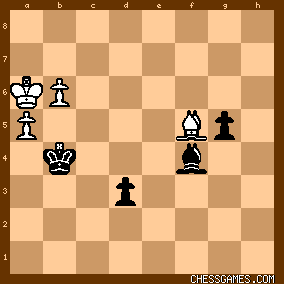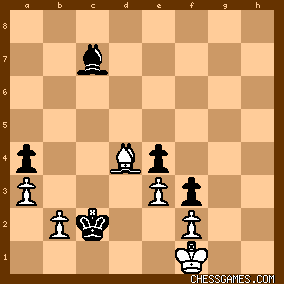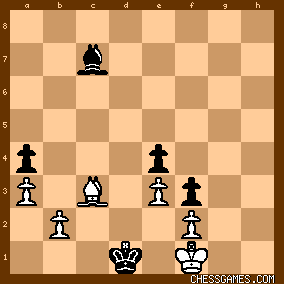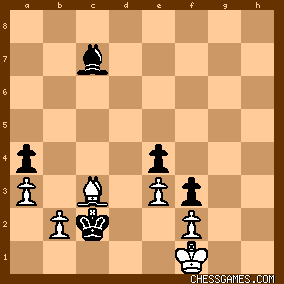|
< Earlier Kibitzing · PAGE 3 OF 4 ·
Later Kibitzing> |
| Jun-13-10 | | VincentL: Wow. c3. I doubt I would have considered this if I had looked at the puzzle for a week. From the other comments, it appears that white can draw. Any further analysis from the engines? |
|
| Jun-13-10 | | Utopian2020: White must always block Black's Bishop. 67. Ke1 allowed Ba5+, with which Black gains the tempo needed to complete his invasion. 67. Bc3 continues White's blockade of Black's bishop. Clearly Black has no forced win. |
|
| Jun-13-10 | | David2009: A postscript to my earlier post: my original assessment of B Pantebre Martinez vs E Paoli, 1976 was completely the wrong way round (after 57...c3! 58 Bxc3 draws, bxc3 loses the exact opposite of my original assessment). I agree with <johnlspouge: [snip] Although I believe White can get his K to c2, it seems drawn to me anyway, because the White B can prevent the Black B from gaining both a1-h8 and a5-e1 diagonals while the Black K is at c2.> I have not been able to find a win against CraftyEGT with colours reversed. Crafty link: http://www.chessvideos.tv/endgame-t... Others may do better: enjoy! |
|
Jun-13-10
 | | OBIT: Even if 57...c3! is conclusively shown to be a draw, it's fair to say it is the best move to try for a win, mainly because against any other move White can play Bc3 and achieve an airtight blockade. In fact, hmm, the White bishop was stationed on c3 only one move earlier. Definitely give 57. Bd4? at least one question mark. |
|
Jun-13-10
 | | Phony Benoni: By the way, Paoli was 68 when this game was played. |
|
| Jun-13-10 | | turbo231: missed it |
|
Jun-13-10
 | | OBIT: Oh, wait... even though 57. Bd4 allowed the pawn sac, White has no good alternatives. If 57. Kh1 Bh2 forces the bishop to move and allowing 58...c3! If 57. Kf1 Kh2 again forces the bishop to move, since 58. Ke1? loses outright to 58...Kg2 followed by ...Bg3. Black uses zugzwang to prepare the pawn sacrifice, what a concept! :) |
|
| Jun-13-10 | | turbo231: < david2009 >
Are the bishops the wrong color? |
|
| Jun-13-10 | | CHESSTTCAMPS: Black appears to have an ideal position in this same color bishop ending, with white having the bad bishop, and black having a strong protected pawn on f3, potentially two moves from promotion if white's f-pawn can be removed. The general plan in such positions is to attack the white pawn chains at the bases, b2 and f2, but this is not an easy task. The WK prevents capture of the f2 pawn by the black bishop (from h4) and can deny the BK access to g2. Furthermore, there are no evident entry points on the queenside for either BK or BB, and the WB is in position to seal the queenside completely with Bc3. This suggests two possible winning attempts for black: (1) Force an exchange of bishops to try to get a winning K&P ending or (2) Sac the c-pawn to create an entry point for the black king at c4. A quick investigation of Plan 1 shows the folly of the idea: In a K&P ending, black's pawns a4, c4, and e4 are all vulnerable targets for the WK and black can't even force the win of the f2 pawn, e.g. 57... Kg4 58.Kf1 Kf5 59.Ke1 Ke6 60.Kd2 Kd5 (a little trap) 61.Bc3! (61.Kc3?? Bg3! wins for black) Be5?? 62.Bxe5 Kxe5 63.Kc3 Kd5 (Kf5 64.Kd4 wins immediately) 64.Kb4 Ke5 65.Kxc4 Kf5 66.Ke4 wins. Therefore, 57...c3! is the only realistic winning plan and accords with the general principle of attacking a pawn chain at its base. Now there are only two reasonable alternatives. A) 58.bxc3 Bxa3 gives black a winning outside passed a-pawn.
B) 58.Bxc3 leaves white's extra b-pawn essentially worthless and opens a critical entry point for the BK at c4.
C) 58.(other) c2 wins immediately for black.
Expanding on the above:
A.1) 59.c4 Kg4 60.c5 Kf5 61.c6 Ke6 62.c7 Kd7 63.Be5 Bc5 followed by Bb6 and Bxc7 wins. A.1.1) 60.Kf1 Bb4! 61.c5 Kf5 and with the WK cut off, white can do no better than lose the c-pawn as in A.1. A.1.2) 60.Kh2 Bd6+ 61.Kg1 Kf5 followed by Be5 promotes the a-pawn. A.2) 59.Kf1 Kf5 60.Ke1 Ke6 61.Kd2 Kd5 62.Kc2 Bc5 63.Bf6 (Bxc5 Kxc5 is a simple K&P ending win) Bxe3! 64.Ba4 Bc5 and the dual threat of a3 and e3 wins. A.2.1) 61.c4 Kd6 62.Kd2 Bc5 63.Kc3 (Bxc5 Kxc5 and outside pawn wins) a3 64.Kb3 Bxd4 65.exd4 e3 wins A.2.1.2) 63.Bf6 Bxe3 64.Ba4 Bc5 wins.
B) 58.Bxc3 (best) Kg4 59.Kf1 Kf5 60.Ke1 Ke6 61.Kd2 Kd5 62.Kc2 Kc4 (Bg3 immediately is met by Be1) 63.Kd2 And after the black king's run to the Q-side, we reach a key position to visualize from the puzzle position: 
click for larger viewWhite, although a pawn up, is in a deadly squeeze, and must eventually lose the f-pawn or the q-side pawns. The WK is courting trouble by being outside the square of the f-pawn, but the WK and WB are overburdened anyway, as the following lines show: B.1) 63.Be4 (or f6) Bg3! wins quickly.
B.2) 63.Bd2 (or a5) Bg3! 64.Be1 Ba5! (and now the WK must give way) 65.Kd2 Kb3 66.Kc1 Bf6 67.Kb1 Bxb2 68.Bb4 Bxa3 wins. B.3) 63.Kd2 Kb3 64.Bf6 (white tries to prevent Bh4) Bf8 65.Bc3 (but can't) Be7 66.Be5 Bh4 67.Ke1 Kc2 68.Bd4 Bd1 69.Bc3 Bc7! and now white is in zugswang: B.3.1) 70.Bd4 (or e5/f6/g7) black wins with Ba5-d2-c1 winning the Q-side pawns. B.3.2) 70.Bb4 or a5 allows either 70... Be5 or Kxb2 with a quick win. B.3.3) 70.Kf1 Kd1 forces the the above choice or leads to loss of the f-pawn. I believe this is it - time to check. |
|
Jun-13-10
 | | tarek1: I am coming very late so I will try to be brief and - hopefully! - repeat what many others have already found by now.
Here I believe that Black wins by realising a plan. White has nothing active to do and can only wait. The plan consists of 6 easy steps :
1.Create an entry point for the Black king on the queenside 2.Attack the f2 pawn with the bishop and tie the white king down to its defense. 3.Bring the king to c2
4.Manoeuver the bishop to c1
5.Take b2 and a3, or if white doesn't allow it, win the f2 pawn. 6.Queen the a and/or the f pawn.
So let's start :
<57...c3 58.Bxc3> Step 1. bxc3 is also possible but the a pawn is more advanced than the c pawn. <58...Be7 59.Kf1 Bh4 60.Bd4> or whatever. Step 2. <60...Kg4 61.Ke1 Kf5 62.Kf1 Ke6 63.Ke1 Kd5 64.Kf1 Kc4 65.Ke1 Kd3 66.Bd4 Kc2> Step 3.
I made white play Ke1-f1 but I don't see anything active or useful he can do : Bg3 loses, b4 loses, he has to guard to f2 pawn. <67.Bd4 Bd8 68.Bc3> preventing Ba5 <68...Bc7> 
click for larger viewMoving the bishop either allows Ba5 or Be5 so
<69.Kf1 Kd1> Now Kg1 allows Ke2 and white will evetually have to move the bishop or lose f2. <70.Bd4 Bd2 71.Bc3 Bc1> Step 4. Now lashing out with b4 loses : <<72.b4 axb3 73.a4 b2 74.Bxb2 Bxb2 75.a5 Be5 76.a6 Bb8>> So
<72.Bd4 Kc2 73.Ke1 Bxb2> and Black wins. I don't know if this is correct or if I missed anything critical or whatever. But I tried :).
Time to check. |
|
Jun-13-10
 | | chrisowen: Doh nuts cop a load of this variety 57..c3 I must have been on the sauce missing it. Attack by stealth enriches black b2 is the target. King bombs around the wing and drops in c2. Bc7 sets the trap take the opposition of shooters check the bishop's entry point a5. Ah says that now but the gas is retiring white's trotted path. A pig skinned black keeps pushing his corner a busting the pawns united. A4 released, habit ably promotes, the pain is none as bishop's blocked b3. |
|
| Jun-13-10 | | gofer: I think this one is basic if you disregard our midweek tactics and
work on basic principles.
1) All of white's pawns are vunerable to the black DSB, but none
of black's pawns are vunerable to the white DSB. This gives black
a huge advantage, so no way is black going to trade off bishops
into a draw or close the game up.
2) As all of black's pawns are on light squares they also control
a lot of the light squares that the white king would like to move
to, but can't. However, these pawns are also blocking the black
king from getting into white's defenses. So what we need to do is
open up one route for the black king, so that the long march g4, f5, e6,
d5 actually leads somewhere! As soon as white plays Bc3 things are
a lot more difficult. So lets open up the c4 square immediately! 57 ... c3
Option 1
========
58 Bxc3 ...
now the white king is blocked from getting to c3 by its own bishop and
the bishop is blocked from e1 because the king must get out of the e1-h1
squares that are severely limiting his play!
58 ... Kg4
time to exploit the open c4 square. Its a long march, but it will be a
fruitful one!
59 Kf1 Kf5
60 Ke1 Ke6
61 Kd2 Kd5
62 Kc2 Kc4
63 Be1 (Pf2 can now only be protected by the bishop) Bh2/Be5 ...and now the squeezing of white's position and begin in earnest... 64 Bc3 Bg3! (the bishop is immune)
65 Be1 Bh4! (black has finally forced zugswang)
66 Kd2 Kb3
67 Kb1 Bf6 winning
Option 2
========
58 bxc3 ...
58 ... Bxa3
both sides have passed pawns but blacks is very far advanced on a4 compared to c3) 59 c4 (allowing Bb2 would be suicide) Bd6
60 c5 Bc7
61 Bb2 (trying to stop c3) Kg4
Again the long march for the black king, but again it will be fruitful!
There is no way the black bishop can protect Pc5 and stop Pa4, so the
king must help as soon as the king moves to the c file Pf2 becomes vunerable.
So its game over there are lots of ways to do this, so I wont bother
covering all except one...
62 Kf1 Kf5
63 Ke1 Ke6
61 Kd2 Kd5
62 Ba3 Kc4 (Kc3 Ba5+ 63 Kc2 Be1 winning or Bd4 a3 63 Kc2 Bg3 winning)
63 Kc2 Be5
64 Bb2 Bxb2
65 Kxb2 Kxc5
66 Kc3 a3
67 Kb3 a2
68 Kxa2 Kc4
69 Kb2 Kd3
70 Kc1 Ke2 winning
Time to check... |
|
| Jun-13-10 | | gofer: Ok, so I managed to find a loss for white in a line that should have been a draw. I think that was wishful thinking to end the analysis on a high note... ...but a draw it is... |
|
Jun-13-10
 | | tarek1: There is mistake in the diagram I poseted : there's no pawn on c4 because Black gave it up on the first move. Also the maneuver Be7-h4 seems to not be found in others' variations... so I wonder if it's necessary ans correct, but at the moment I don't see any refutation to that. |
|
Jun-13-10
 | | tarek1: Correction, re-reading <Eduardo Leon>'s post he had a similar idea, in a different move order. It comes to the same :) |
|
Jun-13-10
 | | Jimfromprovidence: <scormus> <After several rather easy weeks that had some kibitzers moaning…>
Guilty as charged. CG got its mojo back now.
Frankly, I’m surprised that more kibitzers think the position today is a win for white than those who thought it was a draw for white yesterday. On that note, if anyone is interested, I asked a question concerning yesterday’s puzzle R Calvo vs D Byrne, 1968 that still has me guessing whether there is a win or a draw in the following position. I think that black lost the match yesterday with 62…d2 instead of 62…Bf4 below.

click for larger viewIf anyone wants to take a crack at this, it's white to move, looking to win. |
|
| Jun-13-10 | | David2009: So near and yet so far! Following my previous comment (B Pantebre Martinez vs E Paoli, 1976) the game reached, with white to play 
click for larger view Now
67 Ke1 sems to be the decisive mistake - after 67 Bc3 White can keep the Black B from reaching d2 e.g. 67... Bd6 68 Bf6, or
67... Kd3 68.Ke1 Bb6 69.Bf6 Bc5 70.Bg7 and the sacrifice on e3 does not work. Or have I missed something? |
|
Jun-13-10
 | | tarek1: <David2009>
In your diagram, possibly <67...Kd1> by Black wins. It looks like White is in zugzwang : any move by the bishop allows either 68...Be5 or 68...Ba5, a king move allwos Ke2, and <68.b4> loses to <68...axb3 69.a4 Kc2>, winning.For example <67.Bc3 Kd1 68.Bd4 Ba5 69.Be5 Bd2> etc. |
|
Jun-13-10
 | | Phony Benoni: <tarek1> After <67.Bc3 Kd1>

click for larger view
Black's problem is that trading bishops on c3 would allow White's resulting c-pawn to promote. White simply moves his bishop safely, then returns to c3 after Black's bishop takes one of the diagonals. If Black brings his king back before trading, White's king gets e1 back. |
|
| Jun-13-10 | | CHESSTTCAMPS: <Phony Benoni:> Right, I overlooked this point as well. In any case, not too bad an effort, working entirely from the puzzle position. It certainly appears that white could have drawn, but the line played was the best attempt to maximize winning chances. |
|
| Jun-13-10 | | CHESSTTCAMPS: <David2009:> <I have not been able to find a win against CraftyEGT with colours reversed. Crafty link: http://www.chessvideos.tv/endgame-t... Others may do better: enjoy!> Agreed - to me this was proof of incomplete concept. Thanks! |
|
| Jun-13-10 | | SpoiltVictorianChild: Love it. It's so straight forward and logical, yet takes a great mind to see it. |
|
| Jun-14-10 | | Nostrils: < OBIT: Oh, wait... even though 57. Bd4 allowed the pawn sac, White has no good alternatives. If 57. Kh1 Bh2 forces the bishop to move and allowing 58...c3!>
57 Kh1 Bh2 58 Bb4 c3? 59 bxc3! |
|
| Jun-14-10 | | tacticalmonster: 1) White have no counterplay. All black pawns are on light squares while all white pawns are on dark squares 2) Black should win with the principle of two weaknesses: f2 and b2 pawns 3) Black should choose which side black king should infitrate. He should create a mismatch: 1) K and B vs B or 2) K and B vs K 4) Understand that White king should never go beyond the d-file due to the threat of Bg3 winning the f2 pawn 5) Watch out for the breakthrought c4-c3 clearing the c4-a2 diagonal for the king or undermine the defence of a3 pawn. Candidate: 57 c3
a) 58 bxc3 Bxa3 59 c4 Bb4 60 c5 a3 61 c6 Ba5 62 Bc3 a2 63 Be5 Bc7! 64 Bd4 (If 64 Bc3 Kg4 65 Kf1 Kf5 66 Kd1 Be5!  ) Kg4 65 Kf1 Kf5 66 Ke1 Ke6 67 Kd2 Kd5 68 Kc2 Kxc6 69 Kb2 Bg3! ) Kg4 65 Kf1 Kf5 66 Ke1 Ke6 67 Kd2 Kd5 68 Kc2 Kxc6 69 Kb2 Bg3!  b) 58 Bxc3 Kg4 59 Kf1 Kf5 60 Ke1 Ke6 61 Kd1 Kd5 62 Kc2 Kc4 63 Be1 Bf2 64 Bd2 Bg3! 65 Be1 Bh4 66 Kc1 Kb3 67 Kb1 Bf6  |
|
| Jun-14-10 | | tacticalmonster: 
click for larger viewI am convinced after 67 Bc3! White forces a draw. I do not see any winning line for Black To win Black needs to create mismatch in the form of B and K vs B or B and K vs K but Black can achieve neither! After 67 Bc3
a) 67 Kb3 or Kd3 white king gets the e1 square back and it can shuffle bet e1 and f1 undisturbed. b) 67 Kd1 White king cannot move but his bishop can go the d4 now. After 68 Bd4 Ba5 69 Bc3 Black cannot exchange the bishop and he must retreat the bishop back. After 67 Kd1 68 Bd4 Bh2 Black can simply shuffle the bishop along the c3-h8 diagonal c) 67 Bc5 threatens the cheapo 68 Bxa3 but now the bishop cannot join the battle to get to d2 via a5 and White can safely play 68 Bd4. Bxe3 is another possibilty but White is fine as long as white king does not go beyond the d-file. d) The sacrifice bishop for two pawns with Bxa3, bxa3, Kxa3 or Bxe3, fxe3, Kxe3 both fail miserably. Black ends up in a lost positon as verified by Fritz. Black cannot breakthrough because he cannot get his bishop into the attack. If White defends accurately and protect the a5-e1 diagonal, Black will have no choice but to accept the draw. |
|
 |
 |
|
< Earlier Kibitzing · PAGE 3 OF 4 ·
Later Kibitzing> |





